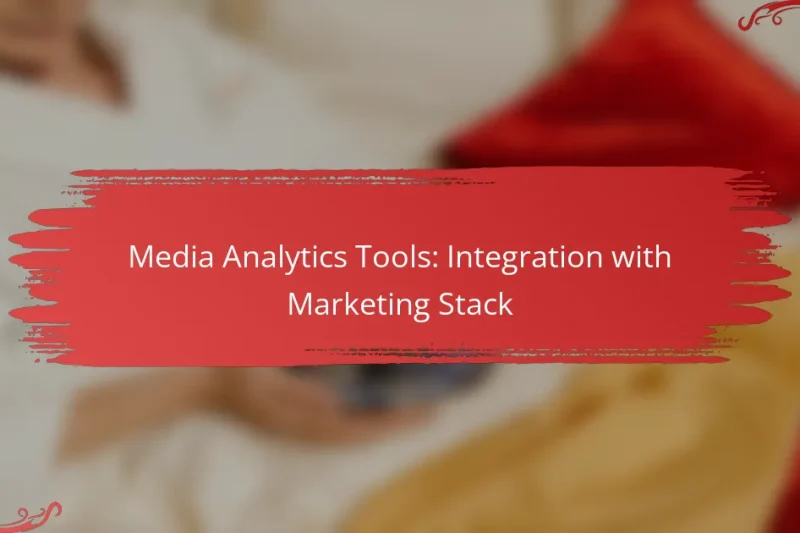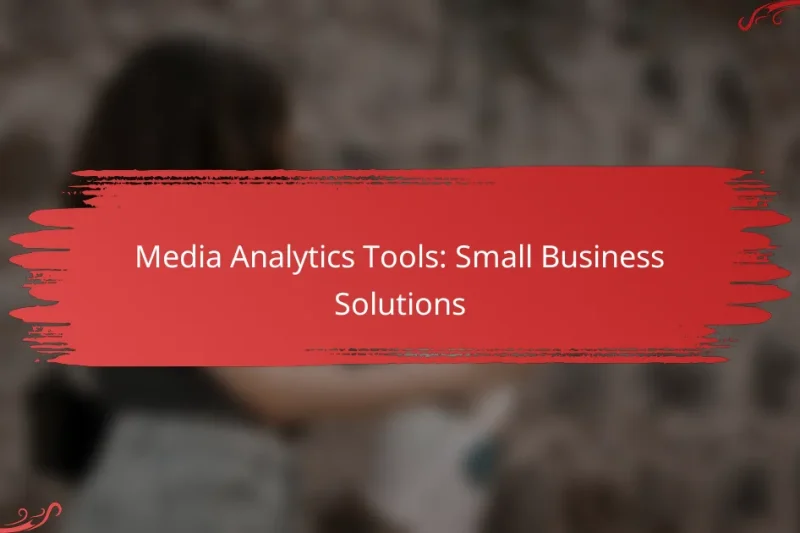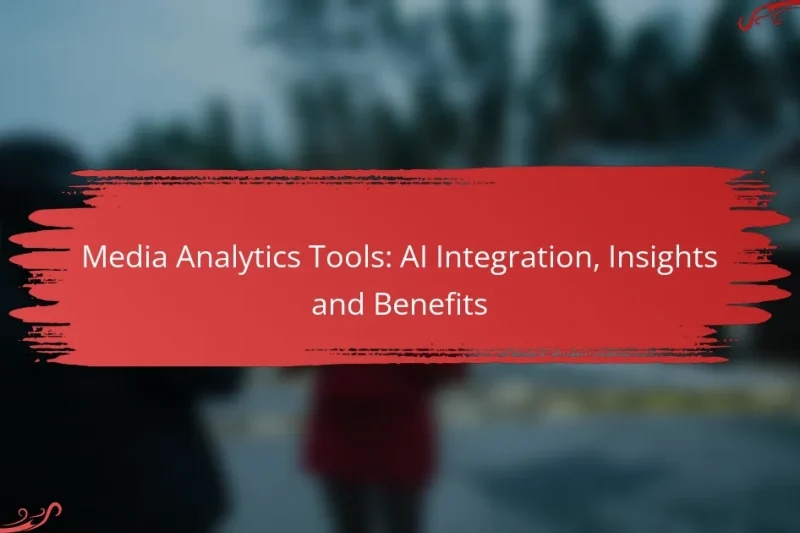Media analytics tools are essential for businesses seeking to optimize their media performance across multiple channels. … Media Analytics Tools: User Reviews and RecommendationsRead more
Media Analytics Tools
Media analytics tools are essential for understanding the effectiveness of display advertising campaigns, offering valuable insights into performance, audience engagement, and conversion rates. By leveraging real-time data, these tools empower marketers to refine their strategies and enhance ad performance, ultimately maximizing return on investment. When choosing the right tools, it’s important to focus on features like cross-channel tracking and custom reporting to ensure comprehensive analysis and integration with existing systems.
Media Analytics Tools: Integration with Marketing Stack
Media analytics tools play a crucial role in enhancing marketing strategies by enabling businesses to track … Media Analytics Tools: Integration with Marketing StackRead more
Media Analytics Tools: Future Trends and Innovations
As the landscape of digital advertising evolves, media analytics tools are becoming increasingly essential for marketers … Media Analytics Tools: Future Trends and InnovationsRead more
Media Analytics Tools: Small Business Solutions
Media analytics tools are essential for small businesses looking to enhance their marketing strategies and understand … Media Analytics Tools: Small Business SolutionsRead more
Free vs Paid Media Analytics Tools: Which Is Better and When to Use
When it comes to media analytics tools, the choice between free and paid options can significantly … Free vs Paid Media Analytics Tools: Which Is Better and When to UseRead more
Media Analytics Tools: AI Integration, Insights and Benefits
Media analytics tools that integrate artificial intelligence are revolutionizing the way professionals analyze data and derive … Media Analytics Tools: AI Integration, Insights and BenefitsRead more
Media Analytics Software: Selection Criteria
Selecting the right media analytics software is crucial for effectively tracking and optimizing media performance. With … Media Analytics Software: Selection CriteriaRead more
What are the best media analytics tools for display advertising?
The best media analytics tools for display advertising provide insights into campaign performance, audience engagement, and conversion metrics. These tools help marketers optimize their strategies by analyzing data from various channels and making informed decisions based on real-time feedback.
Google Analytics 4
Google Analytics 4 (GA4) is a powerful tool that tracks user interactions across websites and apps, offering insights into audience behavior and campaign effectiveness. It utilizes event-based tracking, allowing marketers to measure specific actions like clicks and conversions, which is crucial for display advertising.
To get started with GA4, set up conversion tracking for your display ads and create custom reports to analyze performance metrics. Be aware of the learning curve associated with the new interface and features, but the benefits of enhanced data insights are significant.
Adobe Analytics
Adobe Analytics is a comprehensive analytics solution that provides deep insights into customer journeys and marketing performance. It allows for real-time data analysis and segmentation, making it easier to evaluate the effectiveness of display advertising campaigns.
Consider leveraging Adobe’s predictive analytics capabilities to forecast trends and optimize ad spend. However, keep in mind that Adobe Analytics can be complex and may require a dedicated team to maximize its potential.
Mixpanel
Mixpanel focuses on user engagement and retention, making it ideal for analyzing how users interact with display ads over time. It provides detailed funnel analysis, helping marketers understand where users drop off and how to improve conversion rates.
Utilize Mixpanel’s cohort analysis to track specific user groups and tailor your display advertising strategies accordingly. Its user-friendly interface makes it accessible, but ensure you have a clear strategy for tracking relevant events.
Heap Analytics
Heap Analytics automatically captures every user interaction, allowing for comprehensive analysis without manual event tracking. This feature is particularly beneficial for display advertising, as it provides a complete view of user behavior across campaigns.
To effectively use Heap, focus on defining key metrics that matter for your display ads and utilize its retroactive analysis capabilities to gain insights from past campaigns. This can help identify successful strategies and areas for improvement.
Chartbeat
Chartbeat specializes in real-time analytics, providing insights into audience engagement and content performance. It is particularly useful for display advertising as it helps marketers understand how users interact with ads in real-time.
Leverage Chartbeat’s dashboard to monitor live traffic and engagement metrics, allowing for quick adjustments to campaigns. However, be cautious of relying solely on real-time data; complement it with longer-term analytics for a complete picture of performance.
How do media analytics tools improve ad performance?
Media analytics tools enhance ad performance by providing actionable insights that help marketers make data-driven decisions. These tools track various metrics, enabling businesses to refine their advertising strategies and maximize return on investment.
Real-time data insights
Real-time data insights allow advertisers to monitor their campaigns as they unfold. This immediate feedback helps identify which ads are performing well and which are not, enabling quick adjustments to optimize effectiveness.
For instance, if a particular ad is generating high engagement within the first few hours of a campaign, marketers can allocate more budget to that ad. Conversely, underperforming ads can be paused or modified promptly to minimize wasted spend.
Audience segmentation
Audience segmentation involves dividing the target market into distinct groups based on demographics, interests, or behaviors. This targeted approach ensures that ads reach the most relevant audiences, increasing the likelihood of conversions.
Using media analytics tools, businesses can analyze data to create segments such as age groups, geographic locations, or purchasing behaviors. Tailoring ads to these specific segments can improve engagement rates significantly, often leading to higher conversion rates.
Campaign optimization
Campaign optimization refers to the continuous process of improving ad performance based on collected data. By analyzing metrics such as click-through rates and conversion rates, marketers can identify successful strategies and replicate them across future campaigns.
For effective optimization, regularly review campaign performance and adjust elements like ad copy, visuals, and targeting parameters. A/B testing different versions of ads can also reveal which variations resonate best with the audience, leading to better overall results.
What features should you look for in media analytics tools?
When selecting media analytics tools, prioritize features that enable effective tracking, reporting, and integration. Key functionalities include cross-channel tracking, custom reporting capabilities, and seamless integration with existing systems.
Cross-channel tracking
Cross-channel tracking allows you to monitor user interactions across various platforms, such as social media, websites, and email campaigns. This feature helps you understand how different channels contribute to overall engagement and conversions.
When evaluating tools, ensure they can track multiple channels simultaneously and provide a unified view of user behavior. Look for options that support real-time data collection and reporting to make timely adjustments to your strategies.
Custom reporting
Custom reporting enables you to tailor analytics reports to your specific needs, focusing on metrics that matter most to your business. This feature allows you to visualize data in ways that facilitate decision-making and strategy adjustments.
Consider tools that offer drag-and-drop report builders and the ability to schedule automated reports. This can save time and ensure that stakeholders receive the insights they need without manual effort.
Integration capabilities
Integration capabilities are crucial for ensuring that your media analytics tools work seamlessly with other software, such as CRM systems, marketing platforms, and data warehouses. This connectivity enhances data accuracy and streamlines workflows.
Look for tools that offer APIs or pre-built integrations with popular platforms. This can help you avoid data silos and ensure that all your marketing efforts are aligned and measurable across different systems.
How to choose the right media analytics tool?
Choosing the right media analytics tool involves understanding your specific business needs, evaluating pricing models, and considering user experience. A well-suited tool can enhance your media strategy by providing actionable insights tailored to your objectives.
Assess business needs
Start by identifying the key metrics that matter most to your organization. This could include audience engagement, conversion rates, or brand sentiment. Understanding your goals will help narrow down tools that specialize in those areas.
Consider the scale of your operations as well. For smaller businesses, a basic tool may suffice, while larger enterprises might require advanced features like real-time analytics or integration with other platforms.
Evaluate pricing models
Media analytics tools come with various pricing structures, including subscription-based, pay-as-you-go, or tiered pricing. Assess your budget and determine which model aligns with your financial capabilities and expected usage.
Be wary of hidden costs such as additional fees for premium features or support. It’s wise to compare several options to find a balance between cost and functionality that meets your needs.
Consider user experience
User experience is crucial when selecting a media analytics tool. A user-friendly interface can significantly reduce the learning curve and improve team adoption. Look for tools that offer intuitive dashboards and easy navigation.
Additionally, consider the availability of customer support and training resources. Tools that provide comprehensive documentation and responsive support can enhance usability and help you maximize the tool’s potential.
What are the pricing models for media analytics tools?
Media analytics tools typically employ various pricing models to cater to different user needs and budgets. The most common models include subscription-based pricing, pay-per-use pricing, and freemium models, each offering distinct advantages and considerations.
Subscription-based pricing
Subscription-based pricing involves users paying a recurring fee, often monthly or annually, to access the media analytics tool. This model provides predictable costs and often includes regular updates and customer support. Prices can range from around $10 to several hundred dollars per month, depending on the features and level of service offered.
When considering subscription-based pricing, assess your usage frequency and the specific features you need. Some tools may offer tiered plans, allowing you to choose a package that aligns with your budget and requirements.
Pay-per-use pricing
Pay-per-use pricing charges users based on their actual consumption of the media analytics tool. This model is beneficial for businesses with fluctuating needs, as it allows for flexibility in costs. Users might pay per report generated, data processed, or user seat utilized, making it easier to manage expenses during low-demand periods.
Before opting for pay-per-use, evaluate your expected usage patterns. This model can lead to higher costs if usage spikes unexpectedly, so it’s essential to monitor your consumption closely to avoid surprises.
Freemium models
Freemium models offer basic features at no cost, with the option to upgrade to a paid version for advanced functionalities. This approach allows users to test the tool before committing financially. Many tools provide limited access to data analytics, reporting capabilities, or user seats in their free versions.
While freemium models can be appealing, be cautious of the limitations that may hinder your analytics needs. Assess whether the free version meets your requirements or if the paid upgrades are necessary for your business goals.
What are the common challenges in using media analytics tools?
Media analytics tools often face challenges such as data integration, accuracy, and user interpretation. These issues can hinder effective decision-making and limit the insights derived from media performance data.
Data Integration Issues
Integrating data from various media sources can be complex and time-consuming. Different platforms may use varying formats and metrics, making it difficult to compile a cohesive view of performance. To address this, consider using tools that offer robust APIs or built-in connectors for seamless data aggregation.
Accuracy of Data
Ensuring the accuracy of data collected by media analytics tools is crucial. Inaccurate data can lead to misguided strategies and wasted resources. Regularly auditing data sources and employing validation techniques can help maintain data integrity.
User Interpretation Challenges
Interpreting analytics data requires a certain level of expertise, which may not be present in all teams. Misinterpretation can result in poor strategic decisions. Providing training and clear guidelines on how to analyze and apply data insights can improve understanding and usage across the organization.






